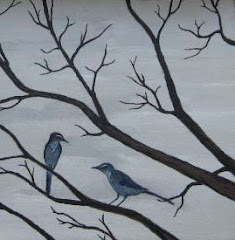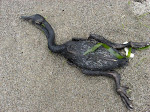As usual, we spent Independence Day weekend in Pacific City. The weather was cold, gray, and wet, a nice break from the heat and humidity of Hillsboro.

On Friday, we brought Andie to the tidepools of Cape Kiawanda. She had a great time jumping on rocks and seeking interesting smells.

While Sarah likes to find rare creatures such as chitons and nudibranchs hidden among the more common residents, I am most interested in two of the main players in the tidepool saga: seastars (
Pisaster ochraceus) and California mussels (
Mytilus californianus). These species seem to be locked in a never-ending battle for survival. The seastars are always looking to have mussels for their next meal, and the mussels seek spots on the rocks that become too dry at low tide for the seastars to survive.

We found a seastar that had just finished one mussel and was holding on to another for its next course. The first mussel had been opened by the star's tube feet, its contents digested by the external stomach of the predator. Life seems tough for mussels, but they are capable of moving along the rocks to find places that are safe from seastars.
We also surveyed our beaches for dead seabirds.

At Bob Straub State Park, we found our second black-footed albatross of our dead bird counting career. It was a molting adult that was fairly intact. We tried to get Andie to pose near it for a size comparison, but she was not interested.

Along the survey routes, we also found a large number of pelagic goose barnacles (L
epas anatifera) stuck to washed-up items such as kelp, driftwood, and bird feathers.

Pelagic barnacles are fascinating creatures that live their lives at sea attached to floating debris until they drift ashore and die. I have seen some that are quite large, about eight inches long, but they can reproduce at small sizes to which they must grow quickly because their time at sea may be limited.

I imagine that forensic scientists would be interested in their growth rates to determine how long certain things had been out to sea.

I had never seen so many attached to so many things before this weekend. I am not sure if the bumper crop we observed is due to currents keeping all this debris at sea long enough to collect many barnacles before washing up or if their are unusually high numbers of barnacle larva out there seeking attachment sites.
 We harvested these purple bush beans last weekend.
We harvested these purple bush beans last weekend.



























































